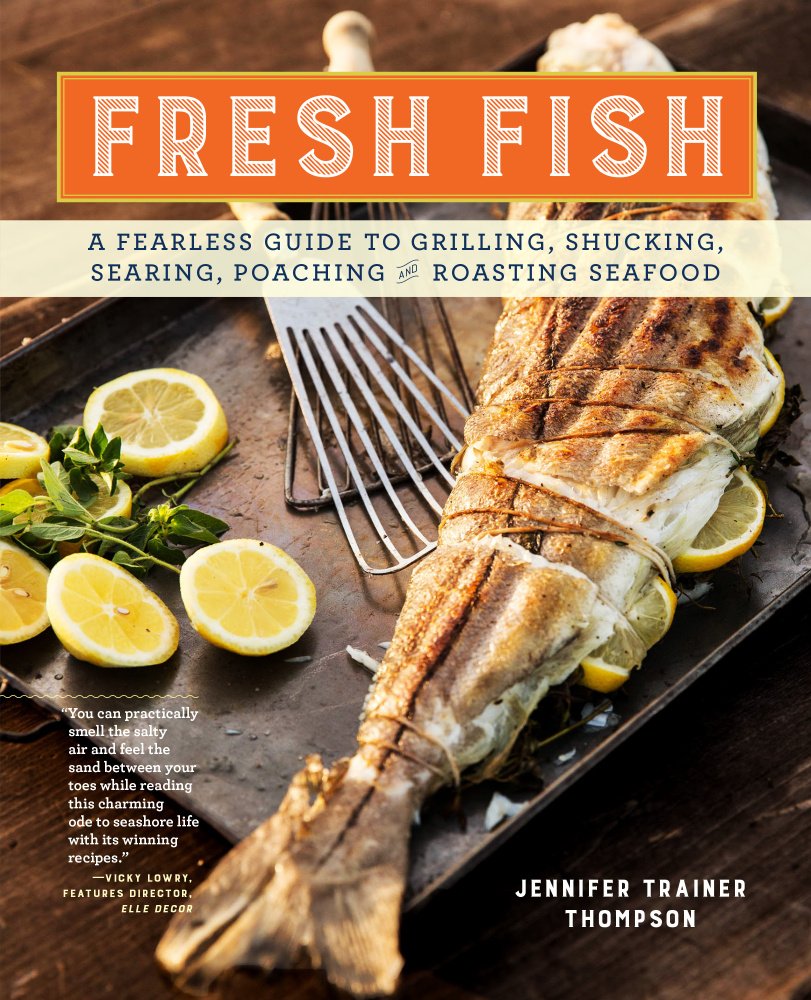“Fresh Fish: A Fearless Guide to Grilling, Shucking, Searing, Packing and Roasting Seafood.” By Jennifer Trainer Thompson. Storey Publishing. 352 pages. $13.30.
Those glossy fish eyes were staring up at me, and I was staring right back.
I have spent most of my life hundreds of miles from any saltwater body. Since graduating college in Indiana, however, I have moved progressively east until Casco Bay is just outside my front door. I know what to do with poultry or beef in my kitchen, but when it comes to gills and shells, I’m a fish out of water.
My boyfriend, Sean, however, has spent his entire life on the East Coast. He’ll place an order for fresh mussels and a cup of clam chowder before I’ve even read the menu. My first meal with his family in New Hampshire included a lesson on how to cook and crack open a lobster.
So there I was at a fish market in Portland, face to face with a glistening dead haddock, emboldened only by the copy of “Fresh Fish: A Fearless Guide to Grilling, Shucking, Searing, Packing and Roasting Seafood” in my bag.
I had turned to Jennifer Trainer Thompson’s cookbook for advice on how to prepare all the fresh seafood in my new neighborhood. She reassured me I could cook Sean’s favorite seafood dishes – and more.
“Fish is sort of weird looking (never mind the bivalves),” she wrote. “It’s slippery. And those eyes: you don’t see eyes staring at you when you buy or are served cow. Let’s get over it. Fish and shellfish are superfoods – lean, one of the world’s most protein-rich foods, good for your brains and your heart. They are remarkably easy to roast in the winter, pan-fry in the fall, stir-fry in the spring, and grill year-round.”
As the title promises, Thompson covers all types of seafood and all manner of preparing it – it’s a big book, 350 pages. The recipes – 175 of them – are divided into chapters like “Things with Shells” and “Things that Swim.” Thompson includes instructions for hosting a lobster-clambake on the beach, plus recipes for side dishes and desserts to accompany the main course.
Directions are clear and concise. As someone who has scratched her head at the fish counter, I was glad to see many recipes included suggestions on substituting one type of fish for another.
The required ingredients often included kitchen staples like rosemary or paprika, and many main courses required less than a half-hour to prepare and cook. I’ll definitely be flipping through the pages again in search of a quick meal.
The pages are full of glossy photos and stories of seaside life – some educational, most simply entertaining. A close read of these passages helped me find tips on grilling fish, cleaning clams and buying a whole fish from a market.
While many individual recipes mentioned the best season for the fish at hand, I could have used a guide for what to buy at different times of the year. The kind folks at Harbor Fish Market directed me to fresh Maine haddock, though I shied away from a whole fish in favor of fillets.
A recipe for Panko-Crusted Skillet-Cooked Haddock with Red Beans and Rice sounded comfortingly similar to chicken dishes I’ve made, but I found the end result lighter and more refreshing.
As I cooked, I was already marking the recipes I wanted to try next. Some, like wood-roasted native striped bass, require more ambition than I have – and equipment I do not own, like a smoker. But most dishes look doable at my stove or backyard grill. The sole en papillote – whitefish baked in parchment paper – seems easier to cook than pronounce.
I’m saving the clam chowder recipe for a snowy weekend when I want a warm meal. Maybe I’ll get really bold and try the seaweed sushi roll.
And as Sean reached for another helping of haddock, I thought, maybe I’ll bring the whole haddock home next time.
PANKO-CRUSTED SKILLET-COOKED HADDOCK WITH RED BEANS AND RICE
FOR THE RED BEANS:
1 tablespoon olive oil
1 tablespoon minced garlic
1/2 small yellow onion, diced,
2 (15.5-ounce) cans red beans
1/2 cup white wine or water
1 tablespoon tomato paste
2 teaspoons oregano
Salt and freshly ground black pepper
FOR THE HADDOCK:
3/4 cup panko breadcrumbs
2 tablespoons chopped fresh flat-leaf parsley
2 teaspoons olive oil, plus more for skillet
2 teaspoons melted butter
1/2 teaspoon sea salt
1/4 teaspoon smoked paprika
1/4 teaspoon freshly ground black pepper
4 haddock fillets, approximately 1/2 pound each
Lemon wedges
Hot rice, for serving
1. To make the beans: Heat the olive oil over medium-low heat in a large skillet. Add the garlic and saute until fragrant, about 1 minute. Add the onion and saute over medium heat until soft, about 10 minutes. Add the beans, wine, tomato paste and oregano, stirring to combine. Lower the heat and simmer for 20 to 30 minutes while you start the fish.
2. To prepare the fish: Preheat the oven to 425 degrees Fahrenheit. In a dry cast-iron skillet, spread the breadcrumbs in a single layer and bake until golden brown, about 5 minutes, stirring once or twice. Place the crumbs in a wide, shallow bowl and toss with parsley, oil, butter, salt, paprika and pepper. Brush the skillet with oil. Press both sides of each fillet into the crumbs, and then lay the fish flat into the skillet. Press any remaining crumbs on top of the haddock. Bake 10 to 12 minutes, or until the fish flakes when lifted with a fork. Serve on a plate with lemon wedges.
3. Stir the beans one last time, season with salt and pepper to taste, and serve with rice and the fish.
Send questions/comments to the editors.


